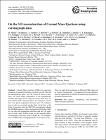On the 3-D reconstruction of Coronal Mass Ejections using coronagraph data
| dc.contributor.author | MC ATEER, ROBERT THOMAS JAMES | |
| dc.contributor.author | GALLAGHER, PETER THOMAS | |
| dc.date.accessioned | 2011-04-05T11:55:15Z | |
| dc.date.available | 2011-04-05T11:55:15Z | |
| dc.date.issued | 2010 | |
| dc.date.submitted | 2010 | en |
| dc.identifier.citation | Mierla, M, Inhester, B, Antunes, A, Boursier, Y, Byrne, JP, Colaninno, R, Davila, J, de Koning, CA, Gallagher, PT, Gissot, S, Howard, RA, Howard, TA, Kramar, M, Lamy, P, Liewer, PC, Maloney, S, Marque, C, McAteer, TJ, Moran, T, Rodriguez, L, Srivastava, N, Cyr, OCS, Stenborg, G, Temmer, M, Thernisien, A, Vourlidas, A, West, MJ, Wood, BE, Zhukov, AN, On the 3-D reconstruction of Coronal Mass Ejections using coronagraph data, ANNALES GEOPHYSICAE, 28, 1, 2010, 203-215 | en |
| dc.identifier.other | Y | |
| dc.identifier.uri | http://hdl.handle.net/2262/54471 | |
| dc.description | PUBLISHED | en |
| dc.description.abstract | Coronal Mass ejections (CMEs) are enormous eruptions of magnetized plasma expelled from the Sun into the interplanetary space, over the course of hours to days. They can create major disturbances in the interplanetary medium and trigger severe magnetic storms when they collide with the Earth's magnetosphere. It is important to know their real speed, propagation direction and 3-D configuration in order to accurately predict their arrival time at the Earth. Using data from the SECCHI coronagraphs onboard the STEREO mission, which was launched in October 2006, we can infer the propagation direction and the 3-D structure of such events. In this review, we first describe different techniques that were used to model the 3-D configuration of CMEs in the coronagraph field of view (up to 15 R?). Then, we apply these techniques to different CMEs observed by various coronagraphs. A comparison of results obtained from the application of different reconstruction algorithms is presented and discussed. | en |
| dc.description.sponsorship | M. M. would like to thank SIDC and ROB for the ?nancial support and for the facilities to carry out this work. M. T. is a recipient of an APART-fellowship of the Austrian Academy of Sciences at the Institute of Physics, University of Graz (APART 11262). We acknowledge the SECCHI/STEREO and SOHO/LASCO consortia for providing the data. The SECCHI data used here were produced by an international consortium of the Naval Research Laboratory (USA), Lockheed Martin Solar and Astrophysics Lab (USA), NASA Goddard Space Flight Center (USA), Rutherford Appleton Laboratory (UK), University of Birmingham (UK), Max-Planck Institute for Solar System Research (Germany), Centre Spatiale de Li`ege (Belgium), Institut d?Optique Theorique et Appliquee (France), Institut d?Astrophysique Spatiale (France). The LASCO data used here were produced by an international consortium of the Naval Research Laboratory (USA), the Laboratoire d?Astrophysique de Marseille (France, the former Laboratoire d?Astronomie Spatiale), the Max-Planck Institute for Solar System Research (Germany), and the School of Physics and Astronomy, University of Birmingham, (UK). SoHO is a project of joint collaboration by ESA and NASA. | en |
| dc.format.extent | 203-215 | en |
| dc.language.iso | en | en |
| dc.publisher | Copernicus Publications | en |
| dc.relation.ispartofseries | ANNALES GEOPHYSICAE; | |
| dc.relation.ispartofseries | 28; | |
| dc.relation.ispartofseries | 1; | |
| dc.rights | Y | en |
| dc.subject | Astrophysics | en |
| dc.subject | Coronal Mass ejections (CMEs) | en |
| dc.title | On the 3-D reconstruction of Coronal Mass Ejections using coronagraph data | en |
| dc.type | Journal Article | en |
| dc.type.supercollection | scholarly_publications | en |
| dc.type.supercollection | refereed_publications | en |
| dc.identifier.peoplefinderurl | http://people.tcd.ie/gallagpt | |
| dc.identifier.peoplefinderurl | http://people.tcd.ie/mcateert | |
| dc.identifier.rssinternalid | 72425 | |
| dc.identifier.rssuri | http://dx.doi.org/10.5194/angeo-28-203-2010 | en |
Files in this item
This item appears in the following Collection(s)
-
RSS Feeds
-
Physics (Scholarly Publications)
Physics (Scholarly Publications)




